Holy Trinity Anglican Cathedral
Parnell
Harrison & Harrison 1969 (3/64 electric)
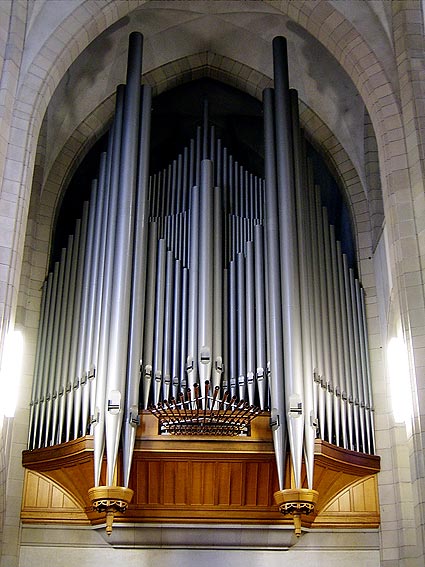
Photo MQ
Prominently placed overlooking the harbour, the building of the cathedral was initiated through a 1935 bequest from newspaper heiress Mina Horton. Construction finally began in 1959, with the sanctuary and transepts completed in the late 1960s to the design of architect Charles Towle. Built in reinforced concrete and brick, these are on a huge scale and comparable with England's Guildford Cathedral. Unfortunately, the nave was not completed at this time, and the present nave, in a radically different style, designed by Richard Toy, was constructed in 1992.
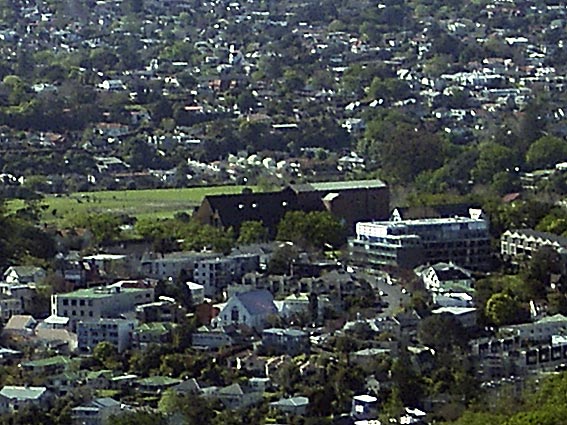
Holy Trinity Cathedral showing both sections in different architectural styles.
The roof of St Mary's Old Cathedral is to the right [MQ]
The organ was built in 1969 by Harrison & Harrison Ltd of Durham and was entirely new at the time. Overall, the tonal design reflects the firm's work at the Royal Festival Hall, under Ralph Downes, Coventry Cathedral, St Albans Abbey and elsewhere. Special features include the use of a full-length 32ft Salicional in the case front, the Cornet combinations available on each manual, the complete choruses, New Zealand's first horizontal reed, and the enclosure of the major pedal reed unit in its own swell box. The instrument was highly influential upon the work of the Croft firm. The console has recently been moved by the South Island Organ Company to the bridge separating the chancel from the nave.
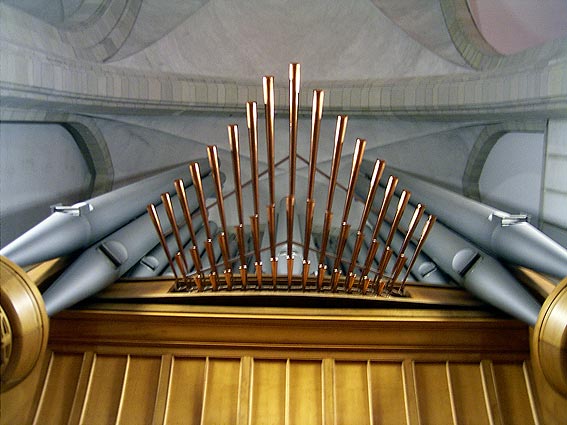
Photo MQ
Harrison & Harrison 1969 (3/64 electric)
| GREAT Salicional Quintadena Open Diapason I Open Diapason II Stopped Diapason Salicional Octave Stopped Flute Octave Quint Super Octave Mixture Cornet Double Trumpet Fanfare Trumpet Trumpet Clarion SWELL Open Diapason Gedackt Gamba Céleste Principal Lieblich Flute Nazard Gemshorn Tierce Mixture Contra Fagotto Trumpet Clarion Tremulant POSITIV Quintadena Principal Rohr Flute Octave Spitz Flute Nazard Block Flute Tierce Larigot Sifflöte Cimbel Corno di Bassetto Krummhorn Tremulant Cornet Double Trumpet Fanfare Trumpet Trumpet Clarion PEDAL Double Salicional Diapason Salicional Bourdon Quintadena Principal Octave Salicional Flute Octave Quint Fifteenth Flute Mixture Trumpet Bombardon Trombone Trumpet Schalmei |
16 16 8 8 8 8 4 4 2-2/3 2 IV V 16 8 8 4 8 8 8 8 4 4 2-2/3 2 1-3/5 IV 16 8 4 16 8 8 4 4 2-2/3 2 1-3/5 1-1/3 1 III 16 8 V 16 8 8 4 32 16 16 16 16 8 8 8 5-1/3 4 2 III 16 32 16 8 4 |
A B A Mid C C D E F G AA B C D E F G A A H B A H D I I I |
I = enclosed unit
8 foot pistons to the Pedal Organ
8 pistons to the Positiv Organ
8 pistons to the Great Organ
8 pistons to the Swell Organ (duplicated by foot pistons)
1 General Cancel piston
1 Doubles Off piston
6 General pistons affecting the whole Organ
Reversible piston to Swell to Positive
Reversible piston to Swell to Great.
Reversible piston to Positive to Great
Reversible piston to Positive to Pedal
Reversible piston to Great to Pedal
Reversible piston to Swell to Pedal
Reversible foot piston to Pedal Trombone
Reversible foot piston to Swell to Great
Reversible foot piston to Great to Pedal
Balanced swell pedals to Pedal Reeds, Positive and Swell Organs
The general pistons are adjustable by setter button; the remainder by switch.
11 couplers
Electro-pneumatic action
Compass: 61/32
Wind pressures up to 12 inches
Information on building from article in Metro Magazine, November 2004, by Rose Hoare
Specification supplied 2006 Bruce Thompson
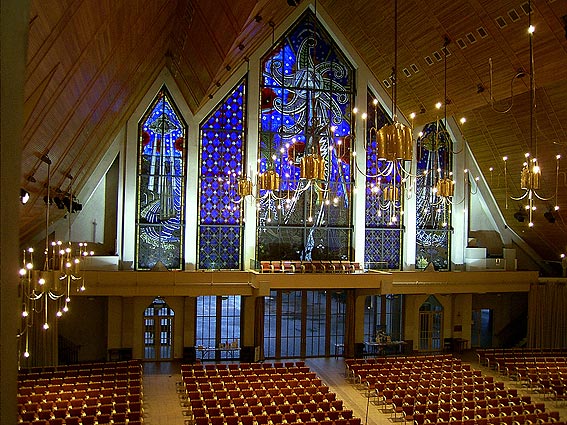
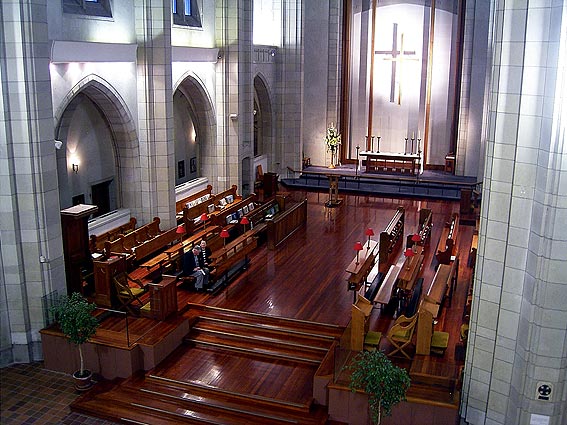
Photos MQ
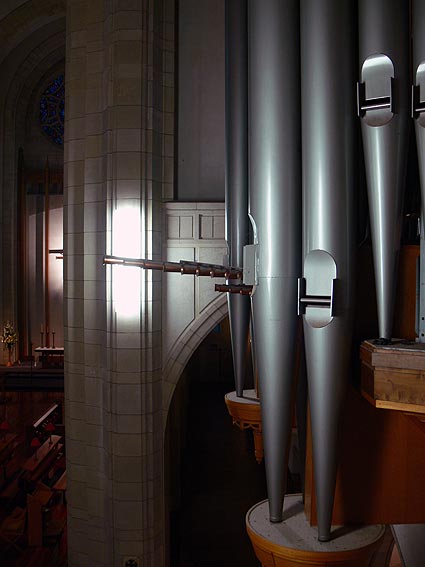 |
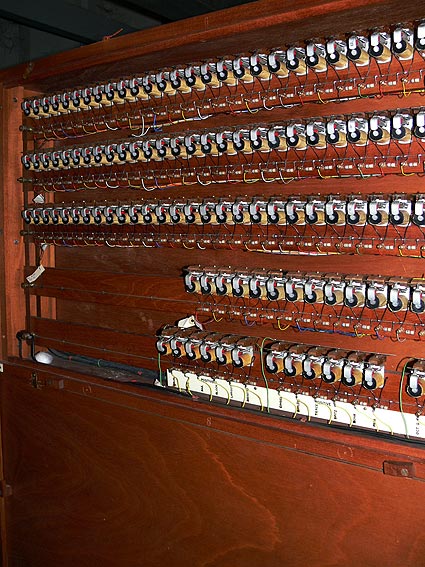 |
|
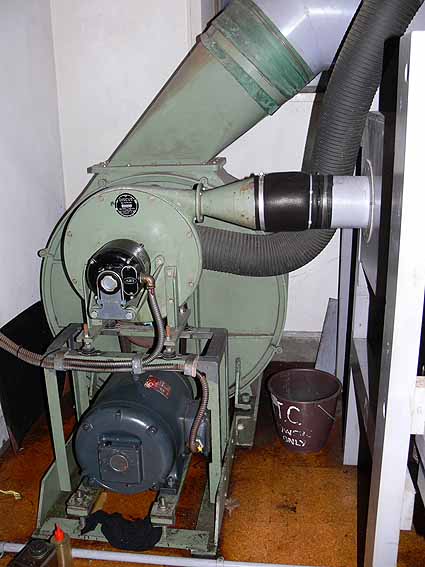 |
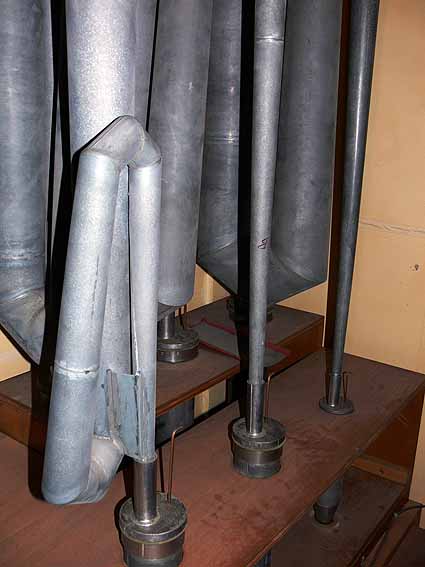 |
|
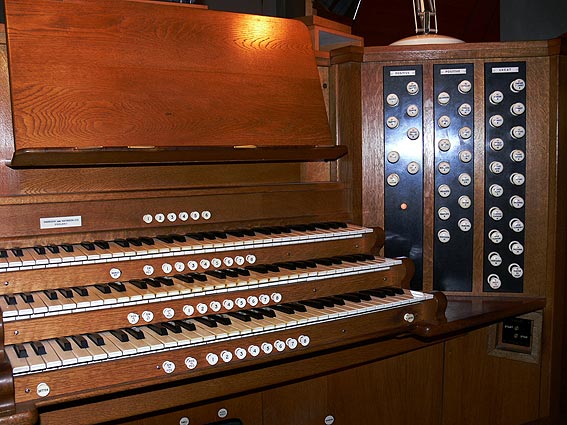 |
||
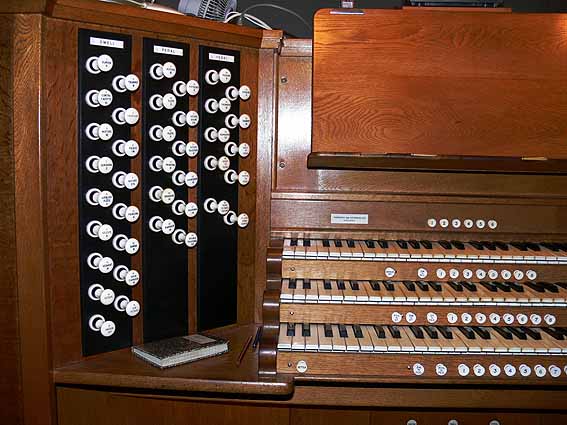 |
||
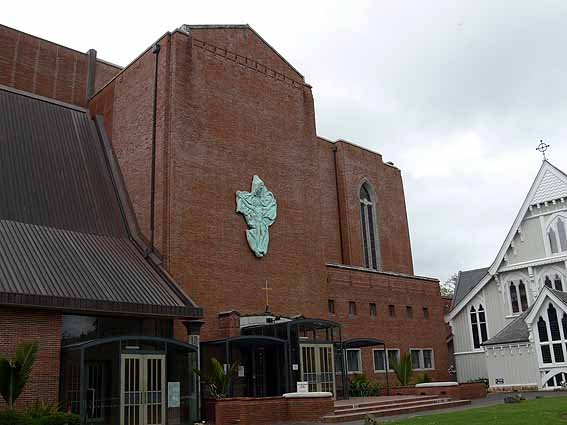 |
||
St Mary's Old Anglican Cathedral
Parnell
George Croft 1909 rebuilt George Croft & Son 1987 (3/41 electric)
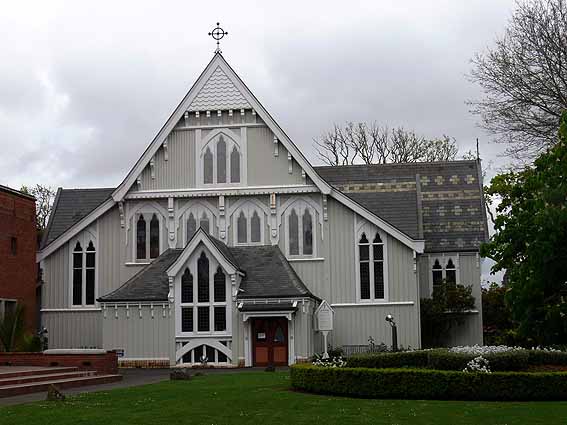
Photo JRM
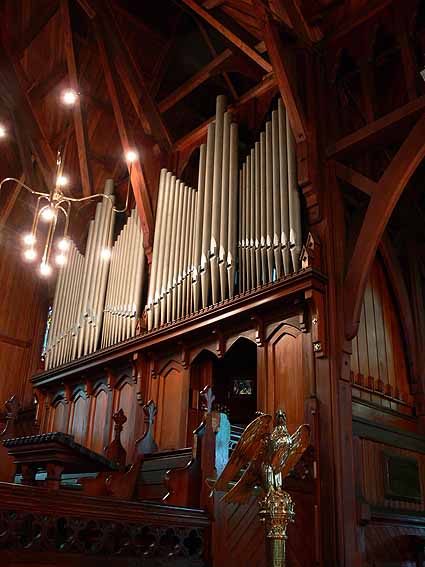
Photo JRM
Designed in 1885 by the important New Zealand architect Benjamin Mountfort, this is the largest wooden church in New Zealand and an internationally significant example of timber construction. It was moved across the adjacent road in 1982 from its previous site to stand behind the east end of the new cathedral. It comprises a broad nave with side aisles and a raised apsidal sanctuary.
The present organ, located to the south of the chancel, was built in 1909 by George Croft, his largest instrument, and replacing a Henry Jones organ now at St Alban's, Balmoral. Regrettably, this splendidly constructed organ was rebuilt by George Croft & Son in 1987 with the removal of the original pneumatic action, electrification and revision of the specification in consultation with Anthony Jennings.
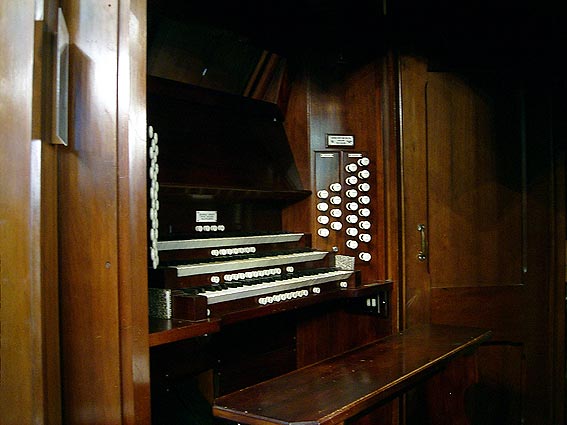
Photo MQ
George Croft 1909 rebuilt George Croft & Son 1987 (3/41 electric)
| GREAT Double Open Diapason Open Diapason I Open Diapason II Claribel Principal Harmonic Flute Fifteenth Sesquialtera 12.17 Mixture 19.22.26 Mixture 29.33 Trumpet Clarion SWELL Open Diapason Lieblich Gedeckt Viol di Gamba Voix Celestes Principal Wald Flute Flautina Mixture 22.26.29 Double Trumpet Cornopean Oboe CHOIR (enclosed) Viola Gedackt Italian Principal Flute Gemshorn Clarinet Trumpet B PEDAL Open Diapason Sub Bass Echo Bourdon Open Diapason Octave Bass Flute Quint Fifteenth Trombone Trumpet Posaune |
16 8 8 8 4 4 2 II III II 8 4 8 8 8 8 4 4 2 III 16 8 8 8 8 4 4 2 8 8 16 16 16 8 8 8 5-1/3 4 16 16 8 |
A * * * B B TC * C * ex Dulciana * B D E ex Swell D A E E * F C F |
* new ranks
8 couplers
Electro-pneumatic action
Attached drawstop console
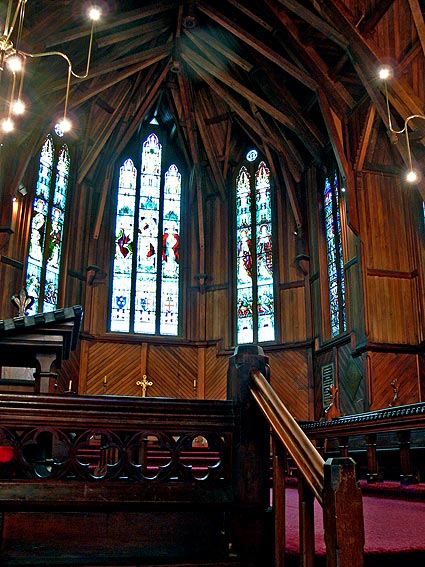 Photo JRM |
||
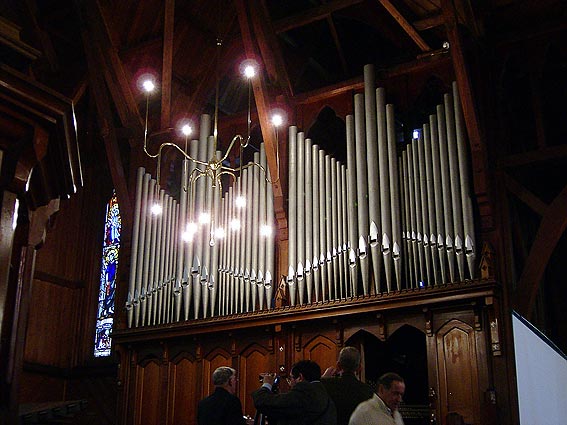 |
John Fields and John Stacpoole, Victorian Auckland. Dunedin: John McIndoe, 1973, nos 101-103
Historic Buildings of Northland and Auckland: a register of classified buildings, compiled by the New Zealand Historic Places Trust. Wellington: New Zealand Historic Places Trust, 1989, p.18
A. Ross Wards, 'St Mary's Cathedral, Parnell, Auckland, Organ News vol 25 no 2 (July 1989) pp 20-25.